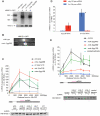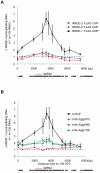A pre-mRNA-associating factor links endogenous siRNAs to chromatin regulation
- PMID: 21901112
- PMCID: PMC3161925
- DOI: 10.1371/journal.pgen.1002249
A pre-mRNA-associating factor links endogenous siRNAs to chromatin regulation
Abstract
In plants and fungi, small RNAs silence gene expression in the nucleus by establishing repressive chromatin states. The role of endogenous small RNAs in metazoan nuclei is largely unknown. Here we show that endogenous small interfering RNAs (endo-siRNAs) direct Histone H3 Lysine 9 methylation (H3K9me) in Caenorhabditis elegans. In addition, we report the identification and characterization of nuclear RNAi defective (nrde)-1 and nrde-4. Endo-siRNA-driven H3K9me requires the nuclear RNAi pathway including the Argonaute (Ago) NRDE-3, the conserved nuclear RNAi factor NRDE-2, as well as NRDE-1 and NRDE-4. Small RNAs direct NRDE-1 to associate with the pre-mRNA and chromatin of genes, which have been targeted by RNAi. NRDE-3 and NRDE-2 are required for the association of NRDE-1 with pre-mRNA and chromatin. NRDE-4 is required for NRDE-1/chromatin association, but not NRDE-1/pre-mRNA association. These data establish that NRDE-1 is a novel pre-mRNA and chromatin-associating factor that links small RNAs to H3K9 methylation. In addition, these results demonstrate that endo-siRNAs direct chromatin modifications via the Nrde pathway in C. elegans.
Conflict of interest statement
The authors have declared that no competing interests exist.
Figures






References
-
- Simon SA, Meyers BC. Small RNA-mediated epigenetic modifications in plants. Curr Opin Plant Biol 2010 - PubMed
Publication types
MeSH terms
Substances
Grants and funding
LinkOut - more resources
Full Text Sources
Other Literature Sources
Molecular Biology Databases

